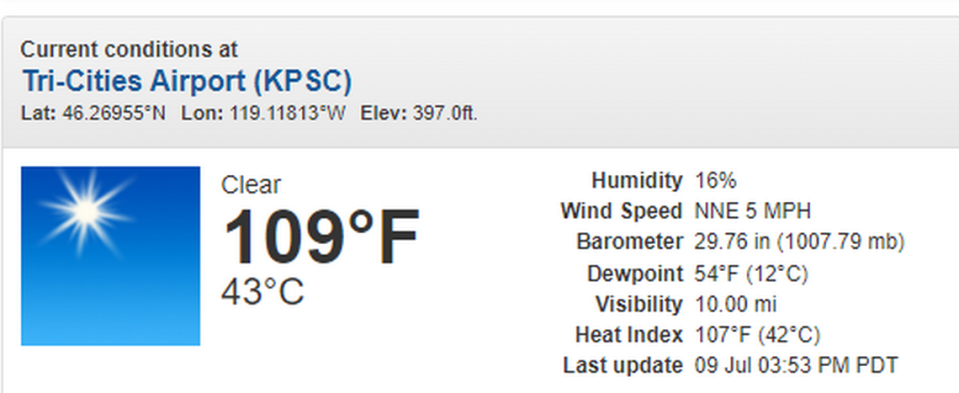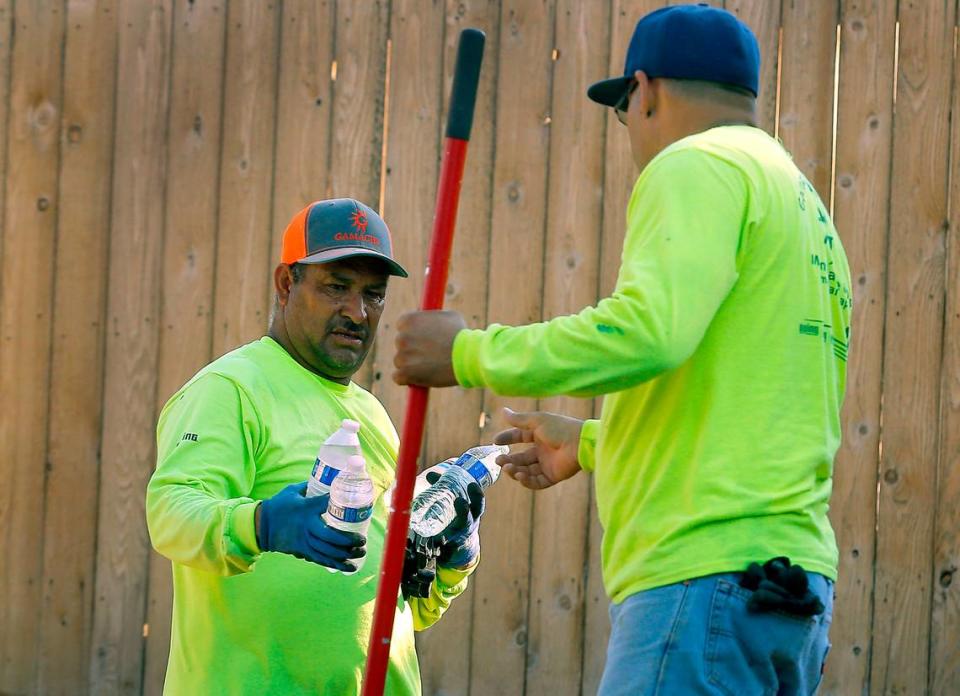Heat record set in 1905 melts in sweltering Tri-Cities heat wave. It’s not over yet
A daily hot weather record for the Tri-Cities that had stood for more than 100 years fell Tuesday.
The National Weather Service reported a temperature of 109 degrees at the Tri-Cities airport just before 4 p.m. Previously the hottest temperature recorded in the Tri-Cities for the date was 106 in 1905.
Wednesday also has the potential to be a record breaker.
The National Weather Service forecasts a high of 108, which would beat the record 106 for the date set in 1975.

Tri-Citians are well accustomed to hot summer temps.
But a string of 100-plus days is taking a toll on outdoor events and prompting reminder that Washington laws require employers to protect outdoor workers against heat exhaustion, stroke or worse..
The Tri-City Union Gospel Mission hadn’t seen a spike in demand for indoor shelter by Tuesday, but expected that could change in the coming days. Andrew Porter, executive director, said more people are stopping by in search of water, which the Pasco shelter provides during hot weather.
As of midday Tuesday, no heat-related deaths had been reported by the Benton and Franklin county coroners.
In Kennewick, the heat wave prompted organizers of the Drums Along the Columbia to delay the start of a performance at Neil F. Lampson Stadium on Monday. Performances by the drum and bugle corps from Colorado, Idaho, Wyoming, Seattle and the Tri-Cities-based Columbians started after 8 pm.
The LIGO observatory at Hanford canceled its tours on Saturday July 13 due to excessive heat risk. They include an unshaded walk of about an hour. Registration for August tours is open.
The Historic Downtown Kennewick Partnership rescheduled its annual Downtown Impact Awards after concluding that it will be too hot Wednesday to safely honor citizens for their contributions to the community.
The Impact Awards program is now set to begin at 5:30 p.m., Sept. 18, at 10 E. Bruneau Ave., Building C. Stephanie Button, executive director, indicated organizers are reconsidering the event schedule in the future with temperatures and possible wildfire smoke events in mind.

Worker heat rules
The current heat wave serves as a handy reminder that Washington law requires employers to provide outdoor workers with access to both water and cool-down facilities.
In 2023, the Washington Department of Labor and Industries conducted more than 412 heat-related inspections and issued 108 citations.
To date in 2024, it has conducted 140 inspections and issued 39 violations.
The workers compensation system accepted 53 heat-related claims in 2022, with farm workers and laborers being the top occupation for claims. Construction was second most common industry to experience heat-related illness.
Workers comp accepted 84 heat claims in 2021, a record driven by the infamous “heat dome” that settled over the region.
The current heat rules, which were updated in 2023, requires employers to be proactive in keeping workers safe.
L&I advises employers to be proactive and ensure that as temperatures rise, they provide sufficient water and rest breaks to prevent heat-related illness or even death.
Protections start when the temperature reaches 80 degrees F, and ramp up with the thermostat.
When temperatures are at or above 90, employers are required to provide a 10-minute cool down rest period every two hours. At 100 degrees F or above, outdoor workers must be offered a 15-minute cool down period every hour.
Employers must a shaded area, air conditioned building or vehicle to provide respite.
The must also provide one quart per hour of cool water per employee.
Heat-related illnesses
Workers showing signs of heat exhaustion should move into shade, drink water and take other steps to avoid serious or even fatal conditions.
Heat exhaustion symptoms include heavy sweating, a fast, weak pulse, cold, pale and clammy skin, headaches, dizziness, nausea or vomiting and weakness and/or ramps.
Heat stroke should be treated as a medical emergency requiring professional treatment. Symptoms include hot, red and dry skin with no sweat, a body temperature of 104 or higher and a fast, strong pulse, nausea and/or loss of consciousness.
Read more about the high heat rules here.
Tri-City Herald reporter Annette Cary contributed to this report.
Sign Up: Boom Town Tri-Cities
Stay up to date on Tri-Cities growth and development with our weekly business newsletter. Get the latest on restaurant and business openings and closings, plus the region’s top housing and employment news. Click here to sign up. In your inbox every Wednesday.


